Learning the friendly way
Dive into our resources, guides, and articles for all things money-related. Grow your financial confidence with our experts curated tips and articles for both experienced and new investors.
LATEST ARTICLEs

Yield farming is a method to generate more crypto with your crypto holdings. The process involves you lending your digital assets to others by means of the power of computer programs known as smart contracts.
Cryptocurrency holders have the option of leaving their assets idle in a wallet or binding them into a smart contract to assist with liquidity. Yield farming allows you to benefit and gain rewards from your cryptocurrency without spending any more of it. Sounds quite easy, right?
Well, hold on because it isn't that straightforward and we are just getting started.
Yield farmers employ highly advanced tactics in order to improve returns.
They constantly move their cryptocurrencies among a variety of lending markets in order to optimize their returns. After a quick Google search, you would wonder why there isn't more content surrounding strategies and why these yield farmers are so tight-lipped about the greatest yield farming procedures.
Well, the answer is quite simple: the more people are informed about a strategy, the less effective it becomes. Yield farming is the lawless territory of Decentralized Finance (DeFi), where farmers compete for the opportunity to grow the highest-yield crops.
As of November 2021, there is $269 billion in crypto assets locked in DeFi, gaining an impressive almost 27% in value compared to the previous month of October.
The DeFi yield farming rise shows that the excitement in the crypto market has extended far beyond community- and culture-based meme tokens and planted itself in the centre of the hype. What exactly does it take to be a yield farmer?
What kinds of yields can you anticipate? Where do you start If you're considering becoming a yield farmer? Here, we'll guide you through everything you need to know.
What is Yield Farming?
Also referred to as liquidity farming, yield farming is a method for generating profits using your cryptocurrency holdings instead of leaving them idle in an account on a crypto website. In a nutshell, it involves bidding cryptocurrency assets into platforms that offer lending and borrowing services and earning a reward for it.
Yield farming is similar to bank loans or bonds in that you must pay back the money with interest when the loan is due. Yield farming works the same way, but this time, the banks are replaced in this scenario by crypto holders like yourself in a decentralized environment. Yield farming is a form of cryptocurrency investment in which "idle cryptocurrencies" that would have otherwise been held on an exchange or hot wallet are utilized to provide liquidity in DeFi protocols in exchange for a return.
Yield farming is not possible without liquidity pools or liquidity farming. But, what is a liquidity pool? It's basically a smart contract that contains funds. Liquidity pools are working with users called liquidity providers (LP) that add funds to liquidity pools. Find more information about liquidity pools, liquidity providers, and the automated market maker model below.
How Does Yield Farming Work?
Liquidity pools (smart contracts filled with cash) are used by yield farming platforms to offer trustless methods for crypto investors to make passive revenue by loaning out their funds or crypto using smart contracts.
Similar to how people create bonds to pay off a house and then pay the bank interest for the loan, users can tap into a decentralized loan pool to pay for the bonds.
Yield farming is a type of investment that involves the use of a liquidity provider and a liquidity pool in order to run a DeFi market.
- A liquidity provider is a person or company who puts money into a smart contract.
- The liquidity pool is a smart contract filled with cash.
Liquidity providers (LPs), also known as market makers, are in charge of staking funds in liquidity pools enabling sellers and purchasers to transact conveniently by executing a buyer-seller agreement utilizing smart contracts. LPs earn a reward for providing liquidity to the pool. Yield farming is based on liquidity providers and liquidity pools, which are the foundations of yield farming. These work by staking or lending crypto assets on DeFi protocols to earn incentives, interest or additional cryptocurrency. It's similar to how venture capital firms invest in high-yield equities, which is the practice of investing in equities that offer better long term results.
Yield farmers will frequently shuffle their money between diverse protocols in search of high yields. For this reason, DeFi platforms may also use other economic incentives to entice more capital onto their platform as higher liquidity tends to attract more liquidity. The method of distribution of the rewards will be determined by the specific implementation of the protocol. By yield farming law, the liquidity providers get compensated for the amount of liquidity they contribute to the pool.
How Are Yield Farming Returns Calculated?
Estimated yield returns are calculated on an annualized model. This estimates the returns that you could expect throughout a year. The primary difference between them is that annual percentage rates (APR) don't consider compound interest, while annual percentage yield (APY) does. Compounding is the process of reinvesting current profits to achieve greater results (i.e. returns). Most calculation models are simply estimates. It is difficult to accurately calculate returns on yield farming because it is a dynamic market and the rewards can fluctuate rapidly leading to a drop in profitability. The market is quite volatile and risky for both borrowers and lenders.
Before Getting Started, Understand The Risks Of Yield Farming
Despite the obvious potential benefits, yield farming has its challenges. Yield farming isn't easy. The most successful yield farming techniques are quite complex, recommended only to advanced users or experts who have done their research.
Here are the different risks:
Smart contract
Smart contracts are computerized agreements that automatically implement the terms of the agreement between parties and predefined rules. Smart contracts remove intermediaries, are less expensive to operate and are a safer way to conduct transactions. However, they are vulnerable to attack vectors and bugs in the code.
Liquidation risks
DeFi platforms, like traditional finance platforms, use customer deposits to create liquidity in their markets. However, if the collateral's value falls below the loan's price, you would be liquidated. Collateral is subject to volatility, and debt positions are vulnerable to under-collateralization in market fluctuations.
If you borrow XX collateralized by YY a rise in the value of XX would force the loan to be liquidated since the collateral YY value would be inferior to the value of the XX loan.
DeFi Rug Pulls
In most cases, rug pulls are obvious exit scams that are intended to entice investors with a well-manufactured promising project in order to attract investors.
A crypto rug pull happens when developers create a token paired with a valuable cryptocurrency. When funds flow into the project and the price rises, developers then seize as much liquidity they can get their hands on resulting in losses for the investors left in.
Impermanent loss
Impermanent loss happens when a liquidity provider deposits their crypto into a liquidity pool and the price changes within a few days. The amount of money lost as a result of that change is what is called an impermanent loss. This situation is counter-intuitive yet crucial for liquidity providers to comprehend.
Exercise Caution When Getting Into Yield Farming
If you have no prior knowledge of the cryptocurrency world, entering into the yield farming production may be a hazardous endeavour. You might lose everything you've put into the project. Yield farming is a fast-paced and volatile industry. If you want to venture into yield farming, make sure you don't put more money in than you can afford, there's a reason why the United Kingdom has recently implemented serious crypto regulations.
What The Future Holds For Yield Farming
We hope that after reading this article you will have a much deeper understanding of yield farming and that it answered some of your burning questions.
In summary, yield farming uses investors' funds to create liquidity in the market in exchange for returns. It has significant potential for growth, but it's not without its faults.
What else might the decentralized financial revolution have in store for us? It's difficult to anticipate what future applications may emerge based on these present components. However, trustless liquidity protocols and other DeFi technologies are driving finance, cryptoeconomics, and computer science forward.
Certainly, DeFi money markets have the ability to contribute to the development of a more open and inclusive financial system that is accessible to everyone with an Internet connection.
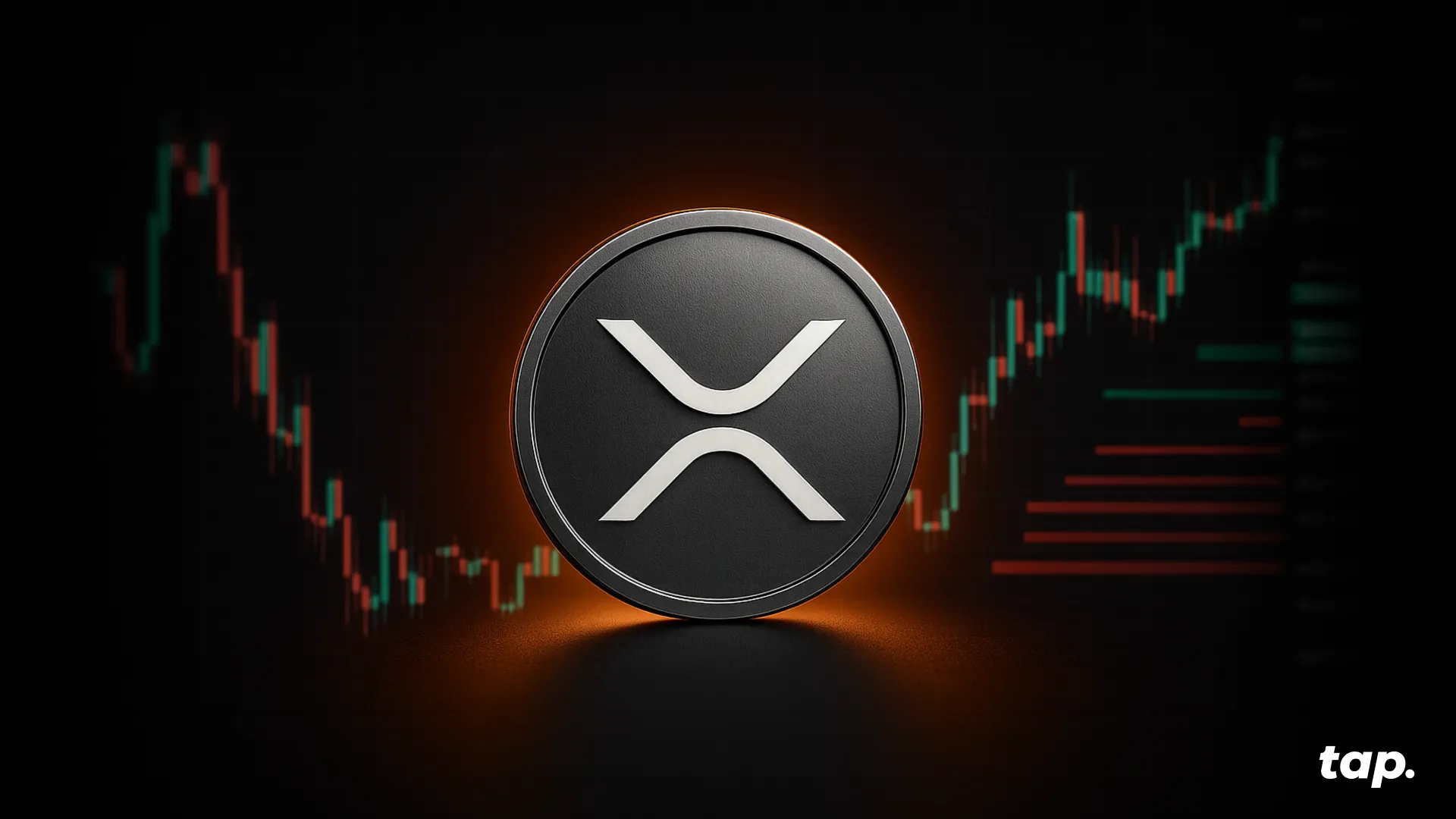
Tease: October has often been unkind to XRP holders. But this year, shifting sentiment, institutional inflows, and a promising setup could finally change the story.
XRP is currently navigating a descending wedge pattern, a chart formation commonly seen as a bullish reversal setup. While past Octobers haven’t favored the token, shifting institutional behaviour and macro catalysts could make this October a turning point.
Demand Under the Surface
Even as price action remained mixed, institutional players kept showing up in September for XRP and other tokens. Total inflows surpassed $220 million, a strong sign that big money sees value despite volatility.
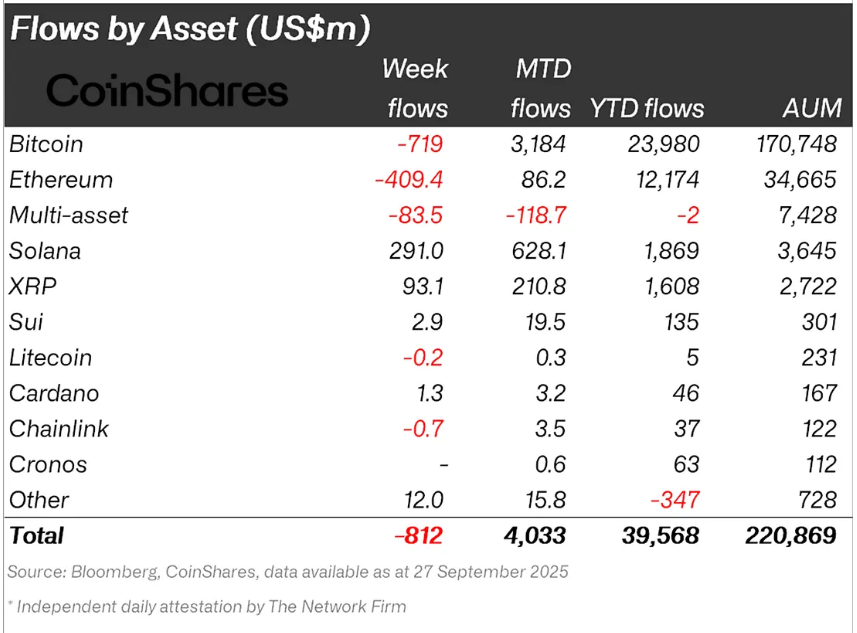
Exchange net positions support the holders’ case. Throughout much of the month, holders brought assets onto exchanges, suggesting short-term selling pressure. Yet in the last week, 439 million XRP were withdrawn from exchanges, a sign that confidence is returning, and fewer coins are available to be sold. This withdrawal trend by both retail and institutional holders indicates a shift from distribution to accumulation, potentially softening downside risk.
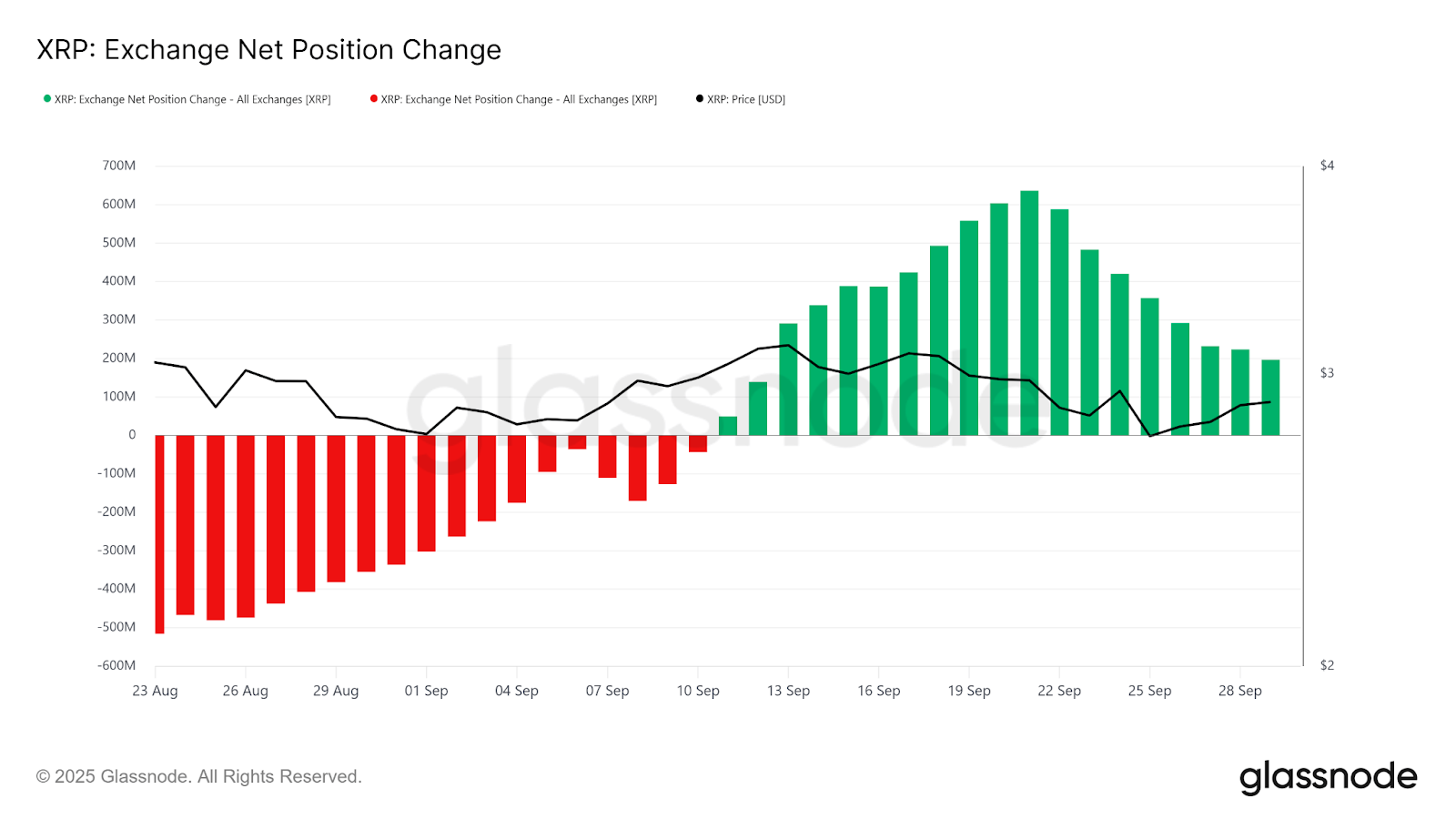
History Doesn’t Always Repeat
Historically, October has been a rough month for XRP. Over the past decade, it has averaged a –4.5% return, making it one of the weaker months for the token.
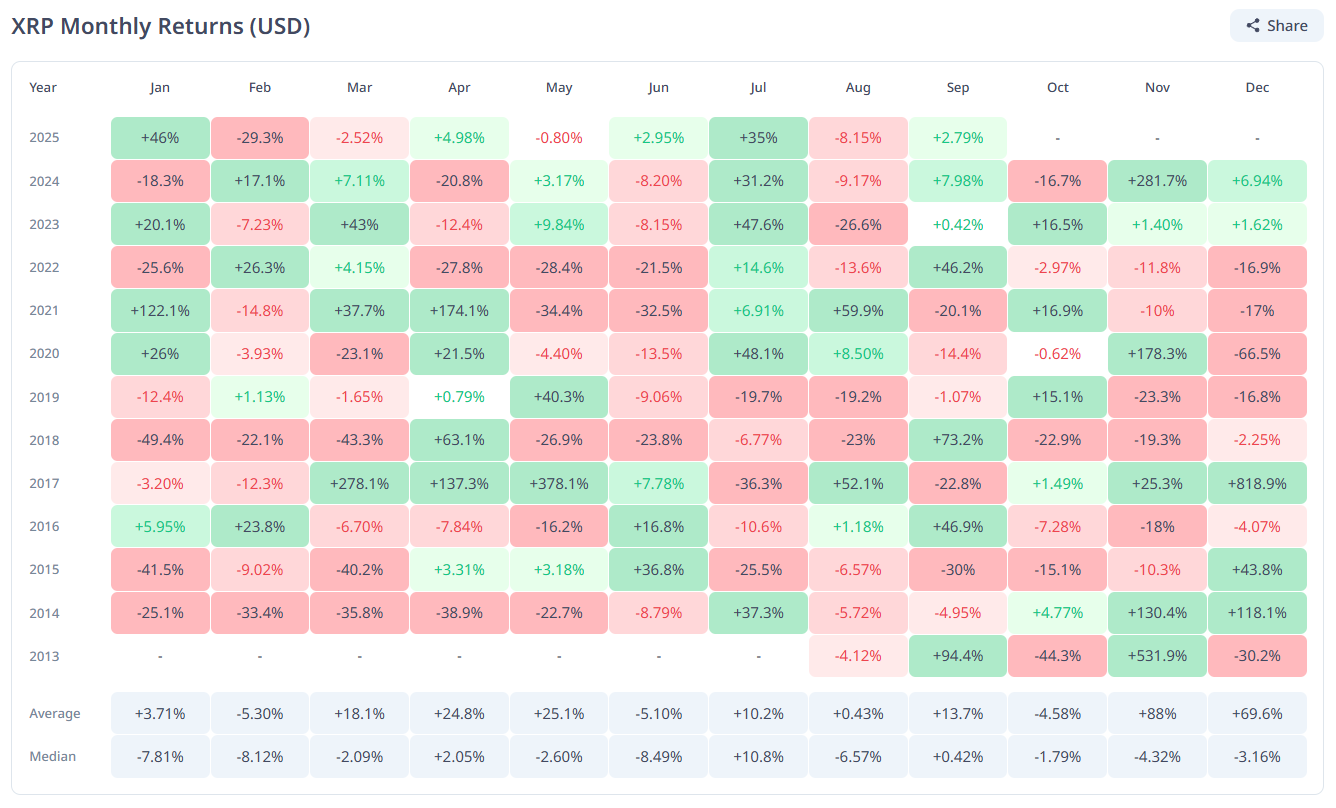
However, past patterns may not fully apply in 2025. It’s worth taking into account that past Octobers occurred during heavy regulatory uncertainty and before institutional infrastructure like ETFs existed. With those catalysts now in play, the usual October weakness may be less relevant this year.
The Price Game: Breakout or Breakdown?
XRP currently trades at around $2.90, trapped between the wedge’s resistance and support lines. A confirmed breakout above $3.02 could set the stage for a rally toward a new all-time high.
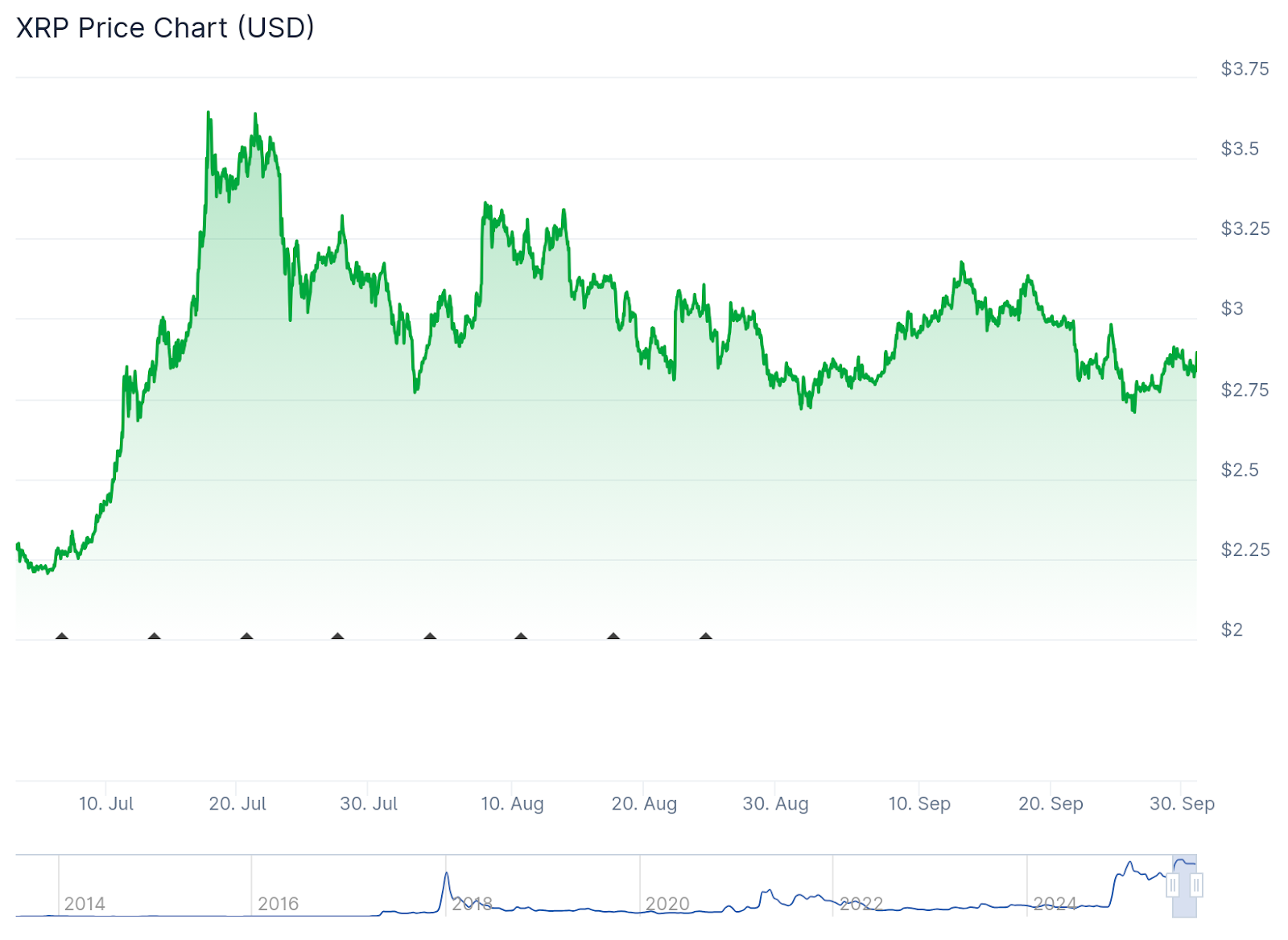
But those gains depend heavily on support levels holding firm and positive regulatory momentum. Should ETF approval chatter or institutional inflows accelerate, XRP could build enough momentum to push through resistance.
Still, risks are real. If the breakout fails, XRP could fall back to $2.75, or even lower, invalidating the bullish thesis and repeating October’s usual pattern of weakness.
What Traders and Holders Should Watch
- $2.75 level as key support, $3.02 as breakthrough resistance.
- ETF approvals or denials could act as volume catalysts.
- Fresh large withdrawals or cold-storage movements suggest longer-term conviction.
- Bitcoin’s strength or weakness often drag altcoins with it, XRP is no exception.
For beginners, this means October is a month to stay alert. For more seasoned traders, this wedge setup is looking like one of the cleaner setups in recent years. If it resolves upward, the upside could surprise some skeptics.
Turning Point
October has historically brought turbulence for XRP, but 2025 offers a different backdrop: institutional flows, ETF speculation, and stronger token infrastructure. The descending wedge pattern gives a clear roadmap. If resistance breaks, bulls may be rewarded; if not, the old October curse could strike again.
That said, XRP’s story is still being written. This month will test whether the narrative has shifted enough to rewrite past patterns. Either way, it’s absolutely shaping up to be an interesting ride.

Gold has got the Midas touch. The precious metal has been on a historic run, surging 45% this year to reach an all-time high of $3,789 per ounce. That kind of parabolic move has left commodities and even crypto markets looking sluggish by comparison. But in financial history, one pattern has repeated itself: when gold runs hot, Bitcoin isn’t far behind.
The question many traders are now asking is simple. Could Bitcoin be about to mirror gold’s rally, just as it has in past cycles?
Why Gold Is Surging
Gold’s meteoric rise began in February 2024 when it finally broke above the $2,100 resistance level after multiple failed attempts. Once through, momentum took over, sending the price soaring nearly 90% from that breakout point.
This rally hasn’t been slow and steady, it’s been almost parabolic. While bullish sentiment is undeniable, some caution flags are waving. The monthly Relative Strength Index (RSI), a common indicator of whether an asset is “overbought” or “oversold, is now at historically high levels. In layman terms, that means gold’s recent surge may be running too hot, increasing the odds of a short-term pullback.
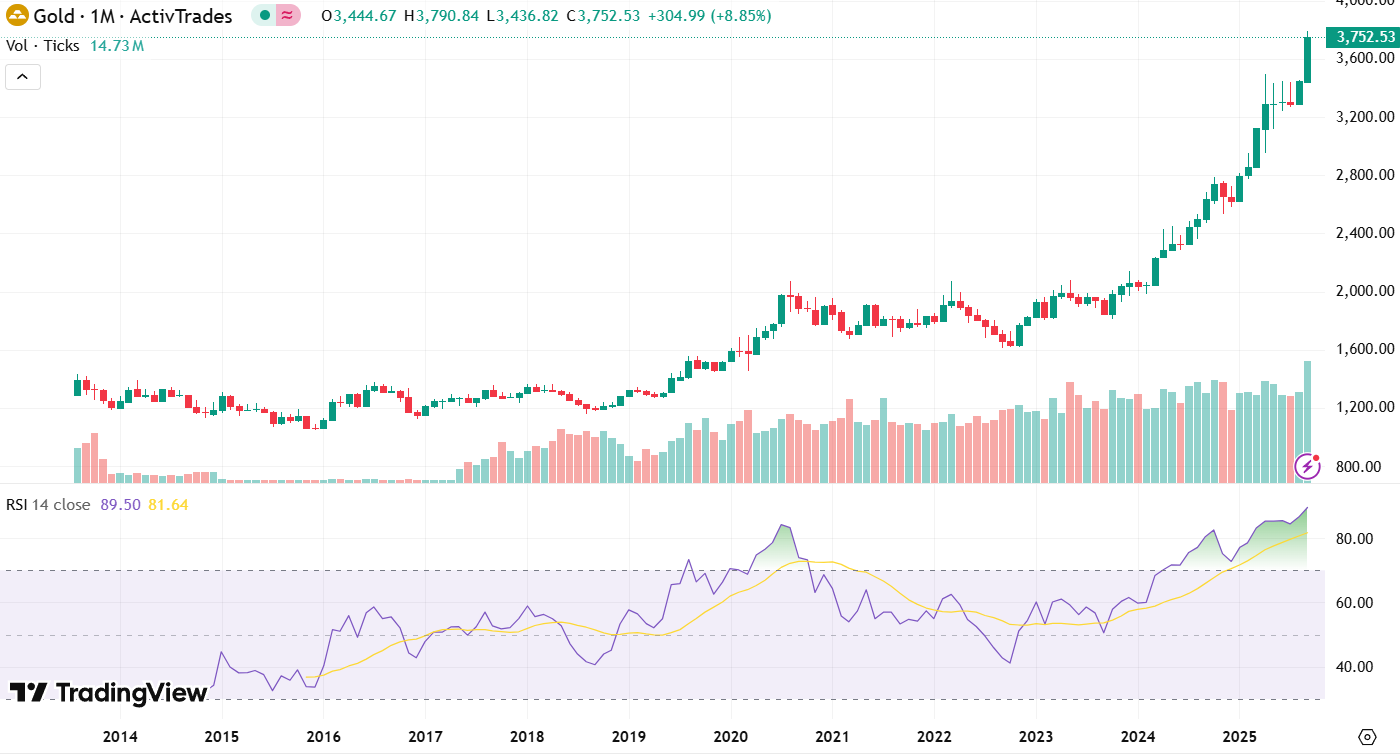
For seasoned traders, that often signals a pullback is coming. Still, even with the possibility of retracement, gold’s rally has further cemented its role as a safe-haven asset during uncertain macro conditions.
The Bitcoin–Gold Correlation
Bitcoin is often referred to as “digital gold,” and not without reason. Both assets share scarcity, gold by nature, Bitcoin by its algorithmic cap of 21 million coins. Both also thrive when confidence in fiat currencies falters.
Historically, Bitcoin and gold have shown positive correlation during major risk-off periods. When fear enters the market, whether due to inflation, geopolitical tension, or financial instability, investors often turn to either or both.
But here’s a twist… During bull markets, their paths tend to diverge.

This pattern has played out at least twice before. For instance, at the end of 2016 and again in 2024, gold’s price surged first, paused, and then Bitcoin picked up the baton with explosive upside momentum. Gold effectively takes the lead, and Bitcoin follows.
With gold now parabolic and at risk of cooling off, history suggests that capital could rotate into Bitcoin next.
Is BTC Ready for Its “Catch-Up” Rally?
Gold’s surge may be nearing exhaustion, but that doesn’t necessarily mean its safe-haven narrative fades. Instead, both assets could share the spotlight: gold as the traditional store of value, Bitcoin as its modern counterpart.
Still, Bitcoin tends to move more aggressively. Where gold posts steady climbs, Bitcoin often reacts in sharper bursts, reflecting its smaller market cap and higher volatility. If capital rotation does occur, Bitcoin’s upside could outpace gold by multiples, as it has in prior cycles.
Some analysts argue that this setup makes Bitcoin uniquely positioned for the months ahead. Gold’s record highs demonstrate demand for hard assets in today’s uncertain world. Even if just a fraction of that demand flows into Bitcoin, the impact could be amplified by its relative size and liquidity profile.
As Good as Gold?
If gold begins to retrace after such a rapid climb, traders and institutions looking for a new vehicle may view Bitcoin as the natural beneficiary. Several factors strengthen this case:
- Market Cycles. Bitcoin has historically entered new uptrends when gold’s momentum stalls, benefiting from shifting capital flows.
- Scarcity Appeal. Bitcoin’s halving in April 2024 cut block rewards to 3.125 BTC, reinforcing its scarcity narrative just as gold’s surge reminded investors of the value of limited-supply assets.
- Institutional Pathways. With U.S. spot Bitcoin ETFs now approved and seeing inflows, access for large investors has never been easier. The structure mirrors how gold ETFs opened floodgates for institutional adoption in the 2000s.
- Digital Hedge Narrative. For younger, more tech-native investors, Bitcoin increasingly plays the role that gold has for older generations; a hedge against inflation, currency debasement, and systemic shocks.
It’s important to remember that correlation does not guarantee causation. While Bitcoin has followed gold in previous cycles, macro conditions today are unique. Global central bank policy, shifting risk appetites, and regulatory landscapes all play a role in shaping Bitcoin’s trajectory.
Moreover, Bitcoin remains far more volatile than gold, which makes it less predictable as a safe-haven asset. Gold is measured in millennia; Bitcoin has just over 15 years of history. The comparison is instructive but not identical.
That said, the parallels are hard to ignore. When gold goes parabolic, Bitcoin often isn’t far behind. And if the pattern of divergence and catch-up repeats, BTC could be setting up for its own moment of glory.
A Golden Opportunity.
Gold’s explosive run to all-time highs has reminded investors (once again) why scarce assets matter during uncertain times. But recent historical data suggests the real story may still be unfolding. Bitcoin could be next in line.
With institutional rails now in place, a halving fresh in the rearview, and gold flashing signs of exhaustion, conditions appear ripe for Bitcoin to step out of gold’s shadow and capture renewed market attention.
The coming months may reveal whether Bitcoin once again mirrors gold’s path, or begins carving out its own.
.webp)
As Solana cements its place as one of the fastest-growing blockchains, the demand for powerful, reliable node infrastructure is skyrocketing. Running your own Solana node isn’t just about plugging into the network; it’s about unlocking earning potential, owning your data, and stepping behind the curtain to see how the ecosystem really works.
Whether you're a developer building apps or an investor looking to participate in network security, this guide will walk you through everything you need to know about setting up and running a Solana node.
Understanding Solana Nodes: types and benefits
What is a Solana Node?
A Solana node is a computer that participates in the Solana blockchain network by storing data, validating transactions, and maintaining network consensus. Think of it as your personal gateway to the Solana ecosystem that gives you direct, unfiltered access to blockchain data.
Validator vs RPC Nodes
Let’s first break down the difference between these two node options. What works best for you usually comes down to your interests, technical background, and what you want to get out of it.
Validator Nodes actively participate in consensus by voting on transactions and producing blocks. They require significant hardware resources and a stake of SOL tokens. Validators earn rewards for their participation but also face potential penalties (slashing) for malicious behaviour.
RPC Nodes serve data to apps and users without participating in consensus. They're easier to run, don't require staking, and are perfect for developers who need reliable blockchain data access for their apps.
Benefits of running a Solana Node
Running your own node offers the following advantages:
- Earning potential: Validators can earn up to 5-8% APY on staked SOL, while RPC nodes can in some case generate revenue through API access fees
- Network independence: No reliance on third-party providers that might have downtime or rate limits
- Data sovereignty: Complete control over your blockchain data access and privacy
- Learning opportunity: Deep understanding of blockchain infrastructure and Solana's architecture
- Network contribution: Help decentralise and secure the Solana network
Hardware requirements and costs
Getting the hardware right is obviously incredibly important for node performance. Before we get into that, let’s first introduce you to Agave.
Essentially, Agave is a validator client for Solana, providing the backbone of validator and RPC node software in the Solana ecosystem. Initially forked from Solana Labs, it now enables independent, optimised deployment and is central to the multi-client future of Solana.
If you’re thinking about running a validator or RPC node on Solana, Agave is the client you’ll most likely use (recommended by Solana).
In short: if you care about your node staying healthy, fast, and compliant with the Solana network as it evolves, you will likely use Agave.
Minimum vs recommended specifications
Here are the official Agave requirements:
CPU:
- Validator: 2.8GHz base clock or faster, 12 cores/24 threads minimum
- RPC Node: 16 cores/32 threads or more
- AMD Gen 3+ or Intel Ice Lake+ required
- AVX2 instruction support mandatory (AVX512f helpful)
- SHA extensions instruction support
RAM:
- Validator: 256GB minimum
- RPC Node: 512GB minimum (1TB recommended for full account indexes)
- ECC memory strongly suggested
Storage: PCIe Gen3 x4 NVMe SSD or better required for each:
- Accounts: 1TB+ with high TBW rating
- Ledger: 1TB+ with high TBW rating
- Snapshots: 500GB+ with high TBW rating
- OS: 500GB+ (SATA acceptable)
- Not recommended to store accounts and ledger on the same disk
Network: 1Gbps symmetric minimum, 10Gbps preferred for mainnet
Operating system: Ubuntu 24.04 (20.04 support ended May 2025)
Hosting options for Solana Validators
Validators don't necessarily need to be "hosted" by third-party providers - you have several options:
1. Self-hosted (own hardware)
- Buy and run your own server at home or in a private data centre.
- Pros: Full control, no recurring hosting fees.
- Cons: Requires enterprise-grade internet (1-10 Gbps), reliable power, security, and 24/7 monitoring.
2. Colocation hosting
- Place your hardware in a professional data centre.
- They provide: Power, cooling, internet, and physical security.
- You handle: Hardware upkeep, software, and monitoring.
- Cost: $100–$500/month + hardware.
3. Dedicated server hosting
- Rent servers from providers (Hostkey, Cherry Servers etc.).
- They provide: Hardware + data center services
- You handle: Validator setup and monitoring.
- Cost: €349–$1,800+/month (depending on service and location)
4. Cloud hosting (not recommended)
- AWS, GCP, and Azure are possible but discouraged for mainnet due to performance issues and higher operational complexity.
Official Solana documentation warns: "Running an Agave node in the cloud requires significantly greater operational expertise" and "Do not expect to find sympathetic voices should you choose this route."
Prerequisites and preparation
Before diving into the setup, ensure you have:
SOL requirements: For validators, you'll need a minimum stake (currently around 1 SOL for vote account rent, plus your desired stake amount). RPC nodes don't require staking.
Technical skills: Basic command-line experience, understanding of Linux systems, and familiarity with SSH connections.
Security setup: Strong passwords, SSH key pairs, and a plan for securing your validator keys.
Network planning: Ensure your internet connection meets bandwidth requirements and has minimal downtime.
Your step-by-step Solana Node setup guide
Phase 1: Local machine preparation
Step 1: Install Solana CLI on your personal computer
- Open terminal on your local machine (not the server)
- Download and run the Solana CLI installer from the official release page
- Verify installation by running the version command to confirm successful setup
Step 2: Create essential keypairs
- Generate validator identity keypair and save as validator-keypair.json
- Create vote account keypair (validators only) and save as vote-account-keypair.json
- Generate authorised withdrawer keypair and save as authorised-withdrawer-keypair.json
CRITICAL SECURITY: The authorised-withdrawer keypair controls your validator's funds. Store it securely offline using a hardware wallet, multisig, etc. Never store this file on your validator server.
Step 3: Configure CLI and create Vote Account (validators only)
- Set your CLI to use the appropriate network (testnet for learning, mainnet for production)
- Set the validator keypair as your default CLI keypair
- Fund the validator keypair with sufficient SOL for vote account creation and ongoing fees
- Create the vote account on the network using the three keypairs
Step 4: Secure the withdrawer key
- Backup the authorised-withdrawer-keypair.json to multiple secure locations
- Remove the withdrawer keypair from your local machine after backup
- Verify you can access your backups before proceeding
Phase 2: Server hardware setup
Step 5: Provision your server
- Set up a server meeting the hardware requirements (dedicated public IP essential)
- Install Ubuntu 24.04 on the system
- Ensure all drives are properly connected and recognised
Step 6: Initial server configuration
- Connect to your server via SSH
- Update all system packages to latest versions
- Install essential build tools and development packages
Step 7: Create dedicated user account
- Create a new user account (typically named "sol" or "solana") for running the validator
- Add the new user to the sudo group for administrative access
- Configure passwordless sudo for convenience (optional but recommended)
Step 8: Storage configuration
- Identify and format your NVMe drives for accounts, ledger, and snapshots
- Create mount points for each drive: /mnt/accounts, /mnt/ledger, /mnt/snapshots
- Mount the drives and set proper ownership to your validator user
- Configure automatic mounting in /etc/fstab to persist after reboots
Phase 3: System optimisation
Step 9: Network and firewall setup
- Configure UFW firewall to allow SSH (port 22) and Solana ports (8000-10000)
- Enable the firewall and verify rules are active
- Ensure your server has a dedicated public IP (NAT not recommended)
Step 10: Critical system tuning
- Create sysctl configuration file to optimise UDP buffers and memory mapping
- Set maximum open file descriptors and memory lock limits
- Configure systemd service limits for file handles and memory locking
- Create security limits configuration for the validator user
Step 11: Apply system changes
- Reload sysctl settings to apply network optimisations
- Restart systemd daemon to recognise new service limits
- Log out and log back in to activate user-level limit changes
Phase 4: Software installation
Step 12: Install Agave Validator Software
- Switch to your validator user account
- Download and install the Solana CLI and Agave validator binary
- Add the Solana binary path to your user's PATH environment
- Verify installation by checking version numbers
Step 13: Transfer keypairs to server
- Securely copy validator-keypair.json and vote-account-keypair.json to the server
- Set proper file permissions (read-only for validator user)
- Never transfer the authorised-withdrawer-keypair.json to the server
Step 14: Create validator startup script
- Create a bin directory in your validator user's home folder
- Write a startup script (validator.sh) with all necessary command flags
- Include paths to keypairs, mount points, network entrypoints, and optimisation flags
- Make the script executable and test it manually first
Phase 5: Service configuration and testing
Step 15: Test manual startup
- Run the validator startup script manually to verify it works
- Monitor the initial startup process and log output
- Check for any immediate errors or configuration issues
- Stop the manual process once confirmed working
Step 16: Create system service
- Create a systemd service file for automatic startup and management
- Configure the service to run as your validator user
- Set up automatic restart policies and logging configuration
- Enable the service for automatic startup on boot
Step 17: Verification and monitoring
- Start the validator service and monitor initial synchronisation
- Verify your validator appears in the gossip network
- For validators: confirm your vote account is visible in the validator list
- Set up log monitoring and performance tracking tools
Step 18: Final checks and go-live
- Verify all system resources are performing adequately
- Confirm network connectivity and peer connections
- For validators: ensure sufficient SOL balance for ongoing vote fees
- Set up monitoring alerts for downtime, performance issues, or errors
Phase 6: Ongoing operations
Step 19: Implement monitoring
- Set up Agave Watchtower or similar monitoring tools on a separate machine
- Configure alerts for validator downtime, performance degradation, or sync issues
- Implement automated restart procedures for common failure scenarios
Step 20: Establish maintenance procedures
- Create regular update procedures for Agave software releases
- Implement log rotation to manage disk space
- Set up backup procedures for configuration and keypairs (except withdrawer)
- Document troubleshooting steps for common issues
Profitability and economics
Earning potential
Validator Rewards: Current estimates suggest 5-8% APY on staked SOL, though this varies based on network conditions and your validator's performance.
RPC Revenue: Can generate income through API access fees, though this requires building a customer base.
Running a validator isn't without risks:
- Slashing: Poor performance can result in stake penalties
- Hardware costs: Equipment failures require immediate replacement
- Market volatility: SOL price fluctuations affect reward values
Break-even analysis
According to online forums, some operators claim to have broken even after 12-18 months, depending on initial hardware investment, operational efficiency, SOL price stability, and network reward rates.
Maintenance and best practices
Regular maintenance ensures optimal performance:
Updates: Keep Solana software current with network upgrades
Monitoring: Set up alerts for downtime, performance issues, or network problems
Backups: Regularly backup validator keys and configuration files
Performance tuning: Monitor CPU, RAM, and network usage to optimise settings
Conclusion and next steps
Running a Solana node can be rewarding both technically and financially in some cases, but it requires significant commitment and resources.
Be sure to consider your technical expertise, available capital, and long-term goals when deciding between self-hosting and alternative solutions.
For additional resources, consult the official Solana documentation and join the validator community on Discord for ongoing support and updates.
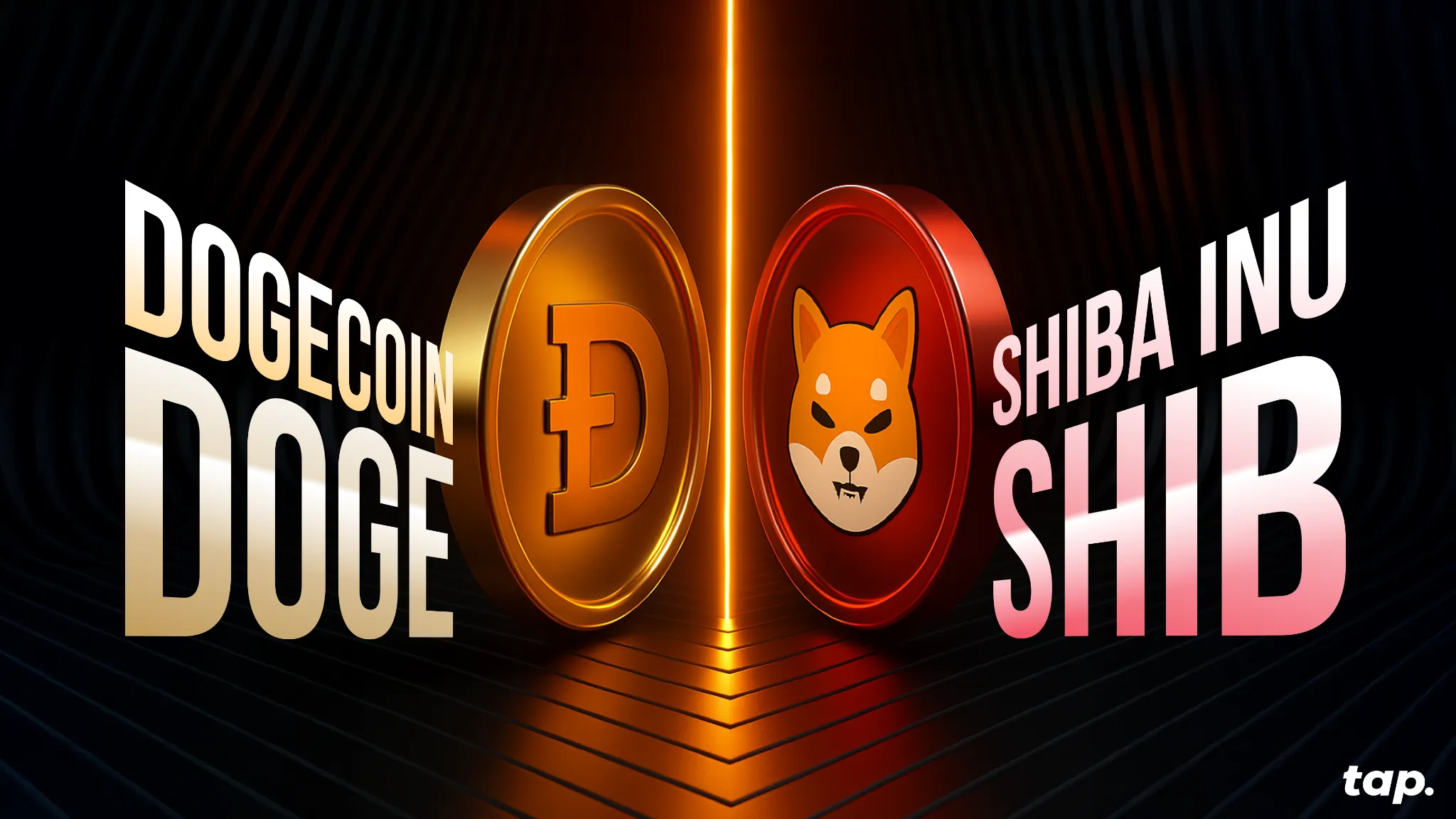
Paw-sitively Profitable
Back in 2013, Dogecoin (DOGE) launched as a tongue-in-cheek knock-off version of Bitcoin (BTC). It was inspired by Kabosu, an incredibly cute Shiba Inu dog that sadly passed away last year, though not without leaving an Instagram account full of posts to remember her by.

The picture that started the meme. Fundamentals… what? Look at this cute doggy. Source.
Fast forward to 2020, and Shiba Inu (SHIB) popped up as a parody of the parody. Both were brushed off as silly, short-lived plays… until they weren’t. In February 2021, a certain billionaire you might have heard of, called Elon Musk, drew attention to Dogecoin through a series of tweets. One could safely pinpoint that tweet spree as the origin of the memecoin bonanza.
Now, let’s fast forward to September 2025. A $100 bet on Dogecoin at $0.0002 would be worth about $124,850 today. The same stake in Shiba Inu at launch? Nearly $25.5 million. Meme magic at its wildest.
For a time, Shiba Inu looked like the stronger contender thanks to its growing ecosystem. But 2025 has flipped the script: SHIB is up a good 24%, while DOGE barked its way to a massive 173% gain. Let’s dig into why.
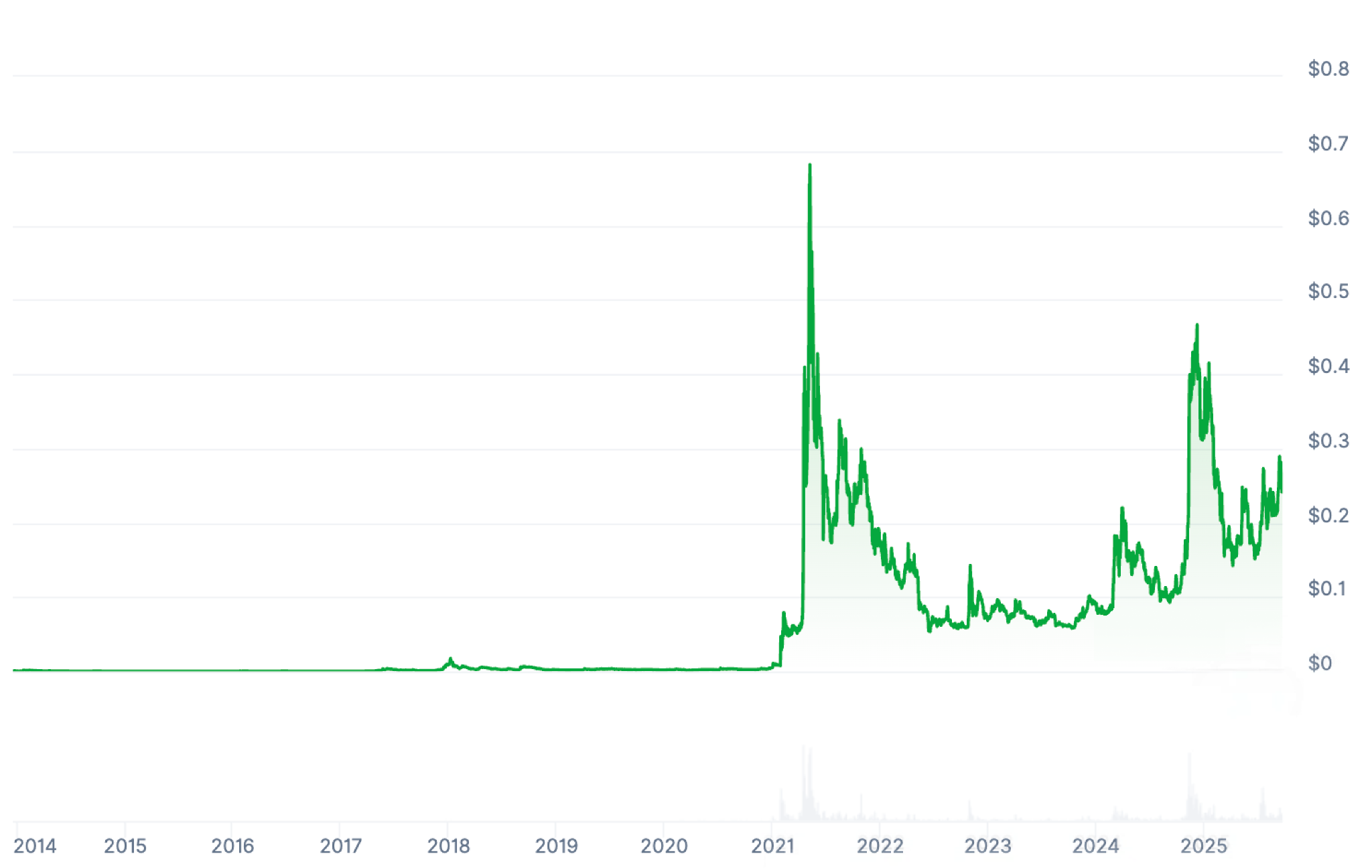
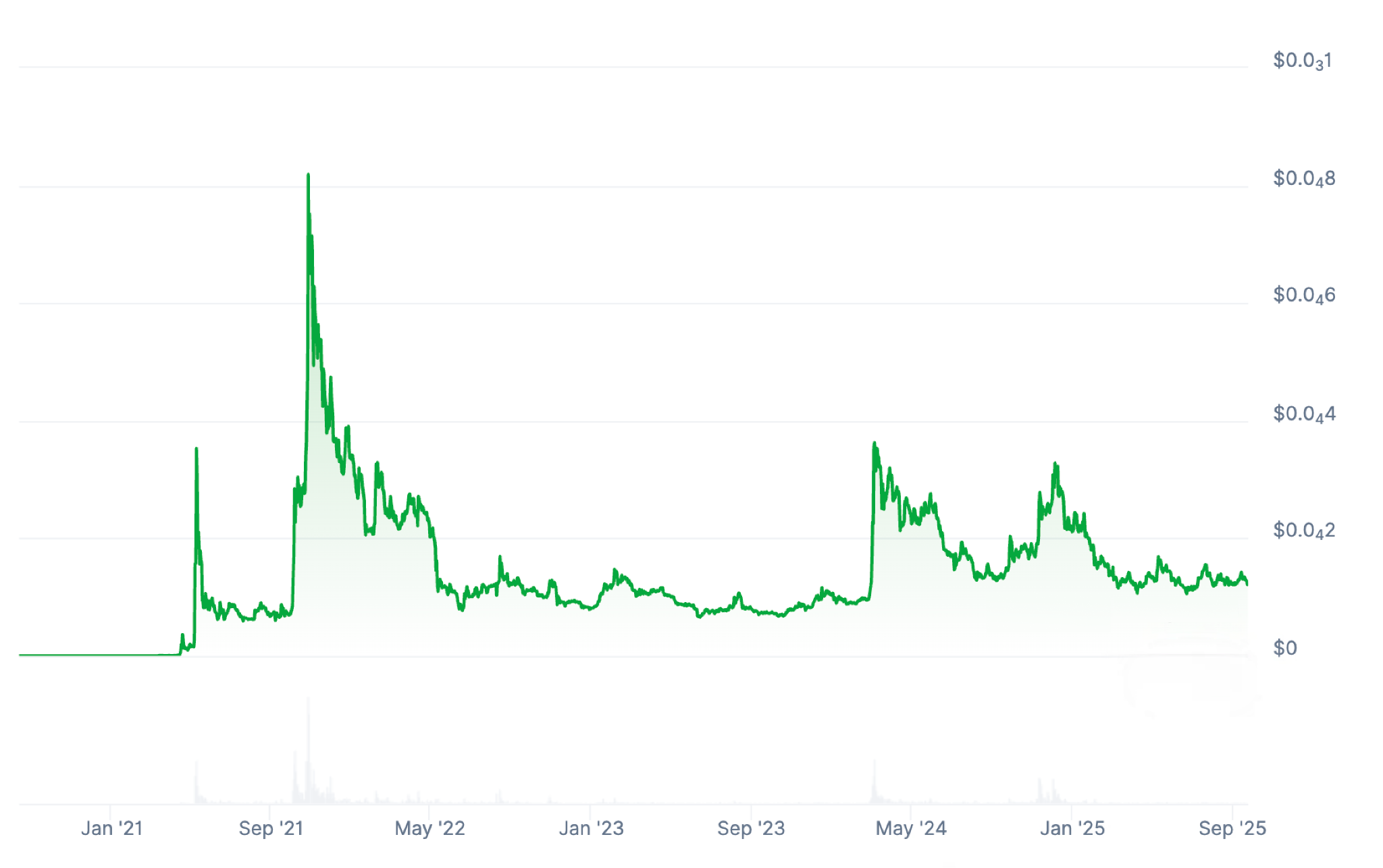
Two Breeds of Dogs
Dogecoin runs on Litecoin’s proof-of-work code, meaning it still relies on miners. It’s inflationary, has no max cap, and uses Scrypt for faster, cheaper payments than Bitcoin. That’s given it a reputation as the “fun” payments coin.
And of course, the Musk effect can’t be ignored. Elon has championed DOGE in tweets, Tesla accepts it for select merch, and even the government’s Department of Government Efficiency was cheekily nicknamed DOGE. Very few coins, memes or not, can summon mainstream buzz the way Dogecoin can.
Shiba Inu, on the other hand, was built on Ethereum. It ditched mining for staking, is deflationary thanks to aggressive token burns (over 40% gone already), and plugs into Ethereum’s smart contract universe. That makes it more versatile than DOGE on paper.
In recent years, Shiba Inu rolled out Shibarium, a Layer-2 chain for speed and lower costs, and ShibaDEX, a cross-chain DEX. The project isn’t just riding a meme, it’s trying to build an ecosystem too.
The Dog Race Is on
For starters, both coins could ride a friendlier U.S. regulatory environment as crypto advocates step into power.
For Dogecoin, near-term ups include:
- Possible integration into Musk’s 𝕏 platform as a payments option.
- Wider retailer adoption.
- Network upgrades for scalability.
- And, of course, the constant wildcard of Musk’s next DOGE tweet.
Rumors of a Dogecoin ETF keep swirling too, which could inject serious momentum.
Shiba Inu’s playbook looks different:
- Ongoing Shibarium growth and new developer activity.
- Token burns that keep tightening supply.
- A developing metaverse with virtual land sales.
However, without a Musk-like hype machine, SHIB’s catalysts may not hit as hard.

Elon Musk’s first Dogecoin tweet, which started it all. Source.
So… Which Meme Coin Will Bark the Loudest?
Both coins are speculative, fueled as much by community buzz as fundamentals. Shiba Inu has a deeper ecosystem and long-term ambition. Dogecoin has clearer short-term sparks and, crucially, Elon Musk’s megaphone.
If forced to pick for the next 12 months, Dogecoin seems to have the edge. It may be the older meme, but for now it still has more bite.

You've likely come across the term "token" in your crypto ventures, or heard Bitcoin and Ethereum described as a token, but what does this all mean? In this article, we're breaking down what a token is, and how to distinguish a coin from a token and how it can be used as a tool to store value.
Token Definition
A token, in the cryptocurrency sense of the world, represents a particular asset or utility. It's worth noting in this item that tokens and cryptocurrencies are terms often used interchangeably however they technically differ. Tokens typically fall into one of the following three categories:
Payment tokens
These tokens allow users to purchase goods and services outside of the blockchain, offering an alternative currency.
Security tokens
Similar to initial public offerings (IPOs) on the stock market, security tokens offer users an ownership stake or entitle the holder to dividends in a blockchain project.
Utility tokens
Utility tokens offer users access to a service within a particular ecosystem, similar to loyalty points on a Starbucks card. These points hold value within their own ecosystem but cannot be used outside of that.
Coins vs Tokens
Getting more technical, when exploring coins vs tokens, tokens are categorised as crypto assets that have been built on top of another blockchain while coins are built on their own blockchain.
Ether, for example, is the native token to the Ethereum blockchain, however, the platform allows developers to create a range of token standards on top of it. Based on this information, all ERC-20 tokens are therefore categorised as tokens as opposed to coins.
USD Coin (USDC) and Tether (USDT) are therefore tokens as they are built on top of the Ethereum blockchain. While each network is operated by its own leadership, both use Ethereum's blockchain to facilitate all transactions.
How Are Tokens Traded?
Much like coins, tokens can be bought, sold and traded on exchanges, or sent directly from one wallet to another. This is facilitated by blockchain technology, in the same way that coins are transferred from one location to another. Unlike coins, which are all fungible in nature, tokens can sometimes be non-fungible, meaning that they are not identical in value and function.
Tokens are sent using the wallet address of a recipient's blockchain-compatible wallet. The address is often represented by a barcode in the form of a QR code, or through a lengthy alphanumeric code. All transactions take place from the wallet holding the tokens and are sent directly to the wallet of the recipient without the need for a centralized authority like a bank. Tokens can typically be bought on exchanges, often with Visa or Mastercard, or exchanged between users.
How is an NFT Different from Cryptocurrency?
Non-fungible tokens (NFTs) are all different from each other as they each represent a real-world object, whether a digital piece of artwork or a bottle of fine wine. Bitcoin can be traded for anything around the world, whereas NFTs are unique in nature and while they hold value they cannot be used interchangeably.
What Are NFTs Used For?
NFTs are used to represent a particular asset, whether it be physical or digital. When minted, these tokens will permanently represent that asset and cannot be changed. For example, one NFT could represent an apartment in London while another could represent a song by Kings of Leon. The possibilities are endless, and the marketplaces are huge.
Users can easily trade NFTs on marketplaces (through a website or mobile app) such as OpenSea or Rarible. Once you own an NFT you are credited with the ownership rights of the asset the NFT represents. Due to the nature of blockchain technology, this is permanently displayed on the network's public ledger for anyone to review. This process ensures that the ownership of an NFT cannot the changed and the information is available for anyone to credit.
Note that several blockchain networks currently support the minting of NFTs, and the holder will need a wallet specific to that blockchain in order to hold the NFT.
Are Tokens Regulated?
When it comes to regulation, countries around the world are currently drawing up legal frameworks to better implement cryptocurrencies into our current financial system. This includes the likes of tokens.
Once cryptocurrencies are regulated by government authorities, they could provide the world with unrealized use cases like being used to manage a prescription at a pharmacy or clinical services or to provide feedback to IT support. While there are plenty of tokens available on the market today, it's likely that this is only the tip of the iceberg in terms of their potential to improve issues faced around the world.
TAP'S NEWS AND UPDATES
What’s a Rich Text element?
What’s a Rich Text element?The rich text element allows you to create and format headings, paragraphs, blockquotes, images, and video all in one place instead of having to add and format them individually. Just double-click and easily create content.
The rich text element allows you to create and format headings, paragraphs, blockquotes, images, and video all in one place instead of having to add and format them individually. Just double-click and easily create content.Static and dynamic content editing
Static and dynamic content editingA rich text element can be used with static or dynamic content. For static content, just drop it into any page and begin editing. For dynamic content, add a rich text field to any collection and then connect a rich text element to that field in the settings panel. Voila!
A rich text element can be used with static or dynamic content. For static content, just drop it into any page and begin editing. For dynamic content, add a rich text field to any collection and then connect a rich text element to that field in the settings panel. Voila!How to customize formatting for each rich text
How to customize formatting for each rich textHeadings, paragraphs, blockquotes, figures, images, and figure captions can all be styled after a class is added to the rich text element using the "When inside of" nested selector system.
Headings, paragraphs, blockquotes, figures, images, and figure captions can all be styled after a class is added to the rich text element using the "When inside of" nested selector system.What’s a Rich Text element?
What’s a Rich Text element?The rich text element allows you to create and format headings, paragraphs, blockquotes, images, and video all in one place instead of having to add and format them individually. Just double-click and easily create content.
The rich text element allows you to create and format headings, paragraphs, blockquotes, images, and video all in one place instead of having to add and format them individually. Just double-click and easily create content.Static and dynamic content editing
Static and dynamic content editingA rich text element can be used with static or dynamic content. For static content, just drop it into any page and begin editing. For dynamic content, add a rich text field to any collection and then connect a rich text element to that field in the settings panel. Voila!
A rich text element can be used with static or dynamic content. For static content, just drop it into any page and begin editing. For dynamic content, add a rich text field to any collection and then connect a rich text element to that field in the settings panel. Voila!How to customize formatting for each rich text
How to customize formatting for each rich textHeadings, paragraphs, blockquotes, figures, images, and figure captions can all be styled after a class is added to the rich text element using the "When inside of" nested selector system.
Headings, paragraphs, blockquotes, figures, images, and figure captions can all be styled after a class is added to the rich text element using the "When inside of" nested selector system.What’s a Rich Text element?
What’s a Rich Text element?The rich text element allows you to create and format headings, paragraphs, blockquotes, images, and video all in one place instead of having to add and format them individually. Just double-click and easily create content.
The rich text element allows you to create and format headings, paragraphs, blockquotes, images, and video all in one place instead of having to add and format them individually. Just double-click and easily create content.Static and dynamic content editing
Static and dynamic content editingA rich text element can be used with static or dynamic content. For static content, just drop it into any page and begin editing. For dynamic content, add a rich text field to any collection and then connect a rich text element to that field in the settings panel. Voila!
A rich text element can be used with static or dynamic content. For static content, just drop it into any page and begin editing. For dynamic content, add a rich text field to any collection and then connect a rich text element to that field in the settings panel. Voila!How to customize formatting for each rich text
How to customize formatting for each rich textHeadings, paragraphs, blockquotes, figures, images, and figure captions can all be styled after a class is added to the rich text element using the "When inside of" nested selector system.
Headings, paragraphs, blockquotes, figures, images, and figure captions can all be styled after a class is added to the rich text element using the "When inside of" nested selector system.What’s a Rich Text element?
What’s a Rich Text element?The rich text element allows you to create and format headings, paragraphs, blockquotes, images, and video all in one place instead of having to add and format them individually. Just double-click and easily create content.
The rich text element allows you to create and format headings, paragraphs, blockquotes, images, and video all in one place instead of having to add and format them individually. Just double-click and easily create content.Static and dynamic content editing
Static and dynamic content editingA rich text element can be used with static or dynamic content. For static content, just drop it into any page and begin editing. For dynamic content, add a rich text field to any collection and then connect a rich text element to that field in the settings panel. Voila!
A rich text element can be used with static or dynamic content. For static content, just drop it into any page and begin editing. For dynamic content, add a rich text field to any collection and then connect a rich text element to that field in the settings panel. Voila!How to customize formatting for each rich text
How to customize formatting for each rich textHeadings, paragraphs, blockquotes, figures, images, and figure captions can all be styled after a class is added to the rich text element using the "When inside of" nested selector system.
Headings, paragraphs, blockquotes, figures, images, and figure captions can all be styled after a class is added to the rich text element using the "When inside of" nested selector system.Kickstart your financial journey
Ready to take the first step? Join forward-thinking traders and savvy money users. Unlock new possibilities and start your path to success today.
Get started



.webp)







.webp)